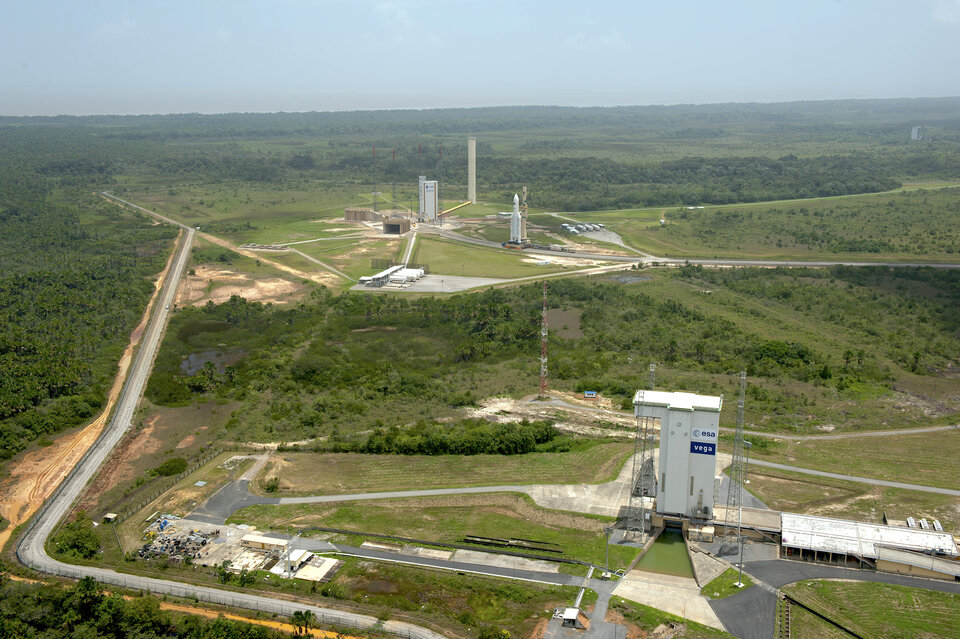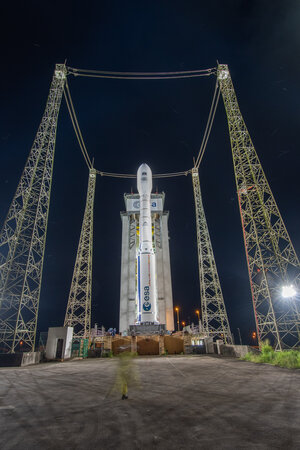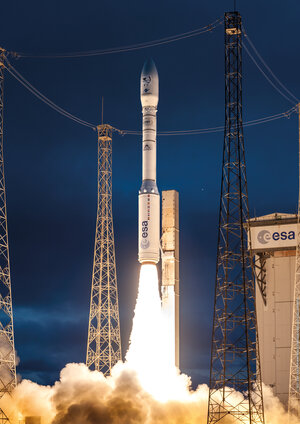Vega-C
ESA’s Vega-C succeeds Vega, to deliver more performance, greater payload volume and better competitiveness. Operating from Europe’s Spaceport in French Guiana, this rocket extends Europe’s autonomy in space by offering new mission possibilities, including return-to-Earth operations with ESA's reusable Space Rider spacecraft. Vega-C features major enhancements including two new solid propulsion stages, an higher-rated upper stage, new fairing, and new ground infrastructure.

Vega-C is a single-body rocket nearly 35 m high with that weighs 210 tonnes on the launch pad. Vega-C can launch 2.3 tonnes to a Sun-synchronous orbit, 3.3 tonnes to low Earth orbit and 2.5 tonnes to polar orbits. Using a new range of payload carriers, Vega-C can accommodate a mix of cargo shapes and sizes, ranging from CubeSats to a large single payload.
Developments will extend Vega-C capabilities to include in-orbit operations and return missions using Space Rider.
Participating States in the Vega-C programme are Austria, Belgium, Czech Republic, France, Germany, Ireland, Italy, Netherlands, Norway, Romania, Spain, Sweden and Switzerland.
Vega-C elements

Vega-C is based on the Vega launch vehicle. As with Vega, its main elements are three solid-propellant stages, an upper stage powered by a reignitable liquid-propellant engine and a payload fairing.
The fairing at the top of Vega-C is 3.3 m in diameter and over 9 m tall, doubling the payload volume that Vega offered. Made of carbon fibre-polymer composite, this structure protects satellites from the thermal, acoustic, and aerodynamic stresses of liftoff and on the ascent through Earth's atmosphere.
The upper stage AVUM+, or Attitude Vernier Upper Module, ensures attitude control and precise orbital positioning and is designed for extended stays in space. AVUM+ holds 740 kg of propellant and the main engine provides an average thrust of 2.42 kN. The reignition capability of the AVUM+ allows Vega-C to reach a range of orbits to deliver multiple payloads on a single mission. Thrusters can burn several times to reach all required orbits. After separation of all the payloads, a final boost can deorbit the upper stage to minimise debris left in orbit.
The third stage, Zefiro-9, is the same as used on Vega and burns 10 t of solid propellant.
The new Zefiro-40 second stage contains 36.2 t of solid propellant, providing an average thrust of 1304 kN.
Vega-C's P120C first stage replaces Vega’s smaller P80 to provide a significant increase in thrust at liftoff. P120C’s monolithic carbon fibre structure weighs about 8000 kg and carries 143.6 tonnes of solid propellant. During its two-minute burn this motor delivers an average thrust of 4500 kN – equivalent to the output of 15 modern airliner engines. The P120C does double service, with either two or four of these solid fuel motors used as boosters for ESA’s Ariane 6 rocket.
Vega-C capabilities
Vega-C’s range of launch adapters that provide the connection between the payloads and the rocket itself make Vega-C very adaptable for launching many types of satellites to different orbits.
Rideshares missions for small satellites.
The Small Spacecraft Mission Service (SSMS) dispenser allows for rideshare launches. The SSMS can be configured to accommodate any combination of 1 kg CubeSats up to 400 kg mini satellites, such as a main large satellite with smaller companions, multiple small satellites or dozens of CubeSats.
Dual passengers
The Vespa-C payload adapter, used for dual passengers with a mass above 400 kg, takes advantage of the larger volume available in the Vega-C fairing.

Single large passenger
The so-called Vampire launch adapter is used for single large payloads.
Return missions
The reusable Space Rider will be launched on Vega-C and use the AVUM+ upper stage to provide in-orbit operations for payload return.
Orbital transfer capability
Developments are under way for a Vega Electrical Nudge Upper Stage, Venus, to move payloads between orbits, for example for constellation deployment, lunar missions or in-orbit servicing.
Vega-E
Work is advancing on an innovative upper stage, to combine the functions of Vega-C’s Zefiro-9 and AVUM+ stages. Reducing the total stage count to three will reduce the complexity of the launch system and reduce launch service costs – while increasing overall performance. The key to this Vega-E variant will be the 10-t class M10 engine, which burns more environmentally sustainable propellants – cryogenic liquid oxygen and methane – and makes extensive use of additive layer manufacturing technologies – so-called 3D printing – to speed up manufacturing and reduce waste and production costs.
Launch zone

Vega-C is launched from Europe’s Spaceport in French Guiana.
The Vega launch complex has been modified to accommodate Vega-C. The mobile gantry has a more powerful crane and new cantilever reinforcements, platform shutters, mast sector and pallets. The fluid services on the launch pad have also been modified.
Roles and responsibilities

ESA owns the Vega-C programme, working with Avio as prime contractor and design authority. Arianespace is responsible for commercial exploitation of the launch system.
The P120C solid rocket motor used by both Ariane 6 and Vega-C is developed by Europropulsion, a joint venture of ArianeGroup and Avio.
France’s space agency, CNES, maintains the Vega-C launch facilities at Europe’s Spaceport.















 Germany
Germany
 Austria
Austria
 Belgium
Belgium
 Denmark
Denmark
 Spain
Spain
 Estonia
Estonia
 Finland
Finland
 France
France
 Greece
Greece
 Hungary
Hungary
 Ireland
Ireland
 Italy
Italy
 Luxembourg
Luxembourg
 Norway
Norway
 The Netherlands
The Netherlands
 Poland
Poland
 Portugal
Portugal
 Czechia
Czechia
 Romania
Romania
 United Kingdom
United Kingdom
 Slovenia
Slovenia
 Sweden
Sweden
 Switzerland
Switzerland


































